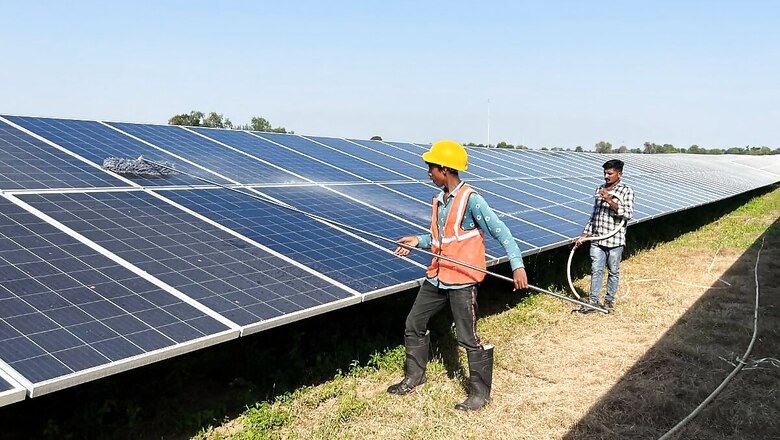
views
Setting the stage for a clean energy transition, India has so far installed 168.39 GW renewable energy capacity, power minister RK Singh told parliament on Wednesday. This includes 46.85 GW of large hydro projects, which have been accorded ‘renewable’ status by the central government.
A major share of this comes from solar power, which contributes as much as 63.89 GW to the entire renewable energy mix, followed by large hydro at 46.85 GW and wind at 41.98 GW. Bio-power provides just 10.73 GW followed by 4.94 GW coming from small hydro Power. In addition, 80.15 GW of capacity is under implementation and 34.83 GW is under tendering, the minister said.
India’s renewable energy push is part of its bigger commitment to meet 50 percent of its power needs from non-fossil fuel based sources by 2030, as announced by Prime Minister Narendra Modi at Glasgow last year.
While the country has missed its 2022 target of adding 175 GW of renewable energy generation capacity by December, it is now eyeing 2030 to meet its goal of 500 GW of installed electricity capacity from non-fossil sources. As on January 31, a total of 175.17 GW capacity from non-fossil fuel-based energy resources has been installed in India, which includes 168.39 GW renewable energy and 6.78 GW nuclear power.
“We are on the cusp of energy transition,” said Aditya Lolla, senior electricity policy analyst at Ember Asia. “Short term, we may be a little behind the target but the overall progress has been encouraging. We saw significant new additions in solar and wind capacity in 2022. States like Gujarat showed significant uptick in wind power. This comes after two years of sluggish growth due to Covid and then the global energy crisis.”
India had installed a record 13 GW of solar capacity in 2022, up 27 percent year-over-year as compared to 10.2 GW in 2021, showed Mercom in its latest assessment. India’s solar capacity now stands at 63.89 GW, compared to 100 GW as envisioned by 2022. But deployment of rooftop solar remains an area of concern due to tardy installation and apprehensions among distribution companies, or discoms, regarding possible revenue losses.
As of February, India has only reported an aggregate rooftop solar capacity of 8.03 GW in the country. “We are certainly progressing on the right track, but the pace could be better. There is a lot of work that needs to be done to ensure a smooth integration of renewable energy in the national grid. We cannot just keep adding new capacity, without considering its impact on the grid,” said Saloni Sachdeva Michael, energy analyst at Institute for Energy Economics and Financial Analysis (IEEFA). “Also, we have to get discoms on board. Most of them are in debt and still apprehensive of more losses due to solar power integration. Then, storage is another critical area, which needs equal attention.”
Read all the Latest India News here















Comments
0 comment